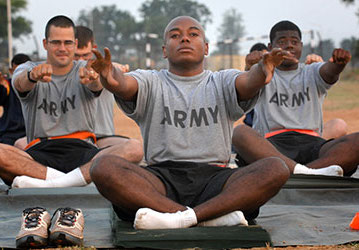Military Service Members can experience a bump, blow, or jolt to the head and sustain a traumatic brain injury (TBI) during training, combat, or day-to-day activities. The majority of those TBIs are mild cases—or concussions—without major structural alterations that show up in brain-imaging tests. However, patients also might experience post-concussion syndrome—when symptoms such as confusion, dizziness, headache, fatigue, disturbed vision, mood alterations, and nausea, last for at least 2 weeks.
New evidence suggests that supervised, low-intensity exercise might help TBI patients recover faster. The previous medical recommendation for people experiencing post-concussion syndrome was to rest until symptoms completely resolved. That’s because exercising at inappropriate intensities might worsen the symptoms. Research studies, however, show that exercise performed below an intensity that causes symptoms (sub-symptom threshold) has the opposite effect and helps speed recovery.
If you have sustained a concussion, however, you should exercise only under the advice and supervision of your medical provider. There are 3 different ways sub-symptom threshold exercise might help you recover from post-concussion syndrome.
Exercise promotes neuronal survival
TBI leads to physical damage to the brain. As a result, brain cells (neurons) die. The death of these neurons leads to chemical damage and further neuronal death, a process known as neurodegeneration. This process of prolonged cell death contributes to symptoms that can persist for many days to weeks after TBI. Currently, there is no effective medicine to prevent or stop neurodegeneration.
However, exercise may help to contain neurodegeneration as it increases the levels of brain-derived neurotrophic factor (BDNF), a protein produced in the brain that supports neuronal growth, survival, and repair. Increased levels of BDNF in the brain actively oppose the process of neurodegeneration. In addition, more BDNF also means better performance in learning and memory tasks. But, for TBI recovery, exercise must be performed below the sub-symptom threshold to increase BDNF. High-intensity exercise makes post-concussion symptoms worse and can cause stress that slows BDNF production.
Exercise balances the autonomic nervous system
The brainstem is a structure located at the base of the brain that is responsible, among other things, for controlling the autonomic nervous system (ANS). When you have a concussion, the brain ricochets inside the skull and can rupture some nerves. Because it’s located at the base of the skull, the brainstem is particularly susceptible to this physical damage, which can alter ANS function. Many post-concussion syndrome symptoms—such as light-headedness, fatigue, exercise-induced headaches, and impaired cardiopulmonary response to exercise—relate to ANS malfunction. Research shows that exercise under the supervision of a qualified medical provider and at the right intensity improves ANS function. Athletes who exercise appropriately after concussion recover faster from post-concussion syndrome symptoms than those who only rested.
Exercise improves blood circulation in the brain
Another change that happens after TBI is reduced blood circulation in the brain. This can last for several days to weeks. In addition to confusion and dizziness, this reduced blood flow also delays the process of brain healing. The brain needs enough oxygen and glucose to recover from injury. If that doesn't happen, neurodegeneration can continue. Blood flow in the brain needs to match the brain’s metabolic needs, or healing doesn’t take place.
When you exercise, the chemicals released in your brain help increase local blood circulation. This gives your brain more access to oxygen and glucose, so it heals faster from TBI. Better blood flow also helps relieve symptoms of confusion, dizziness, and lightheadedness.
 Find out how to work out around exercise limitations Learn More
Find out how to work out around exercise limitations Learn More
Intensity matters
Exercise is emerging as “medicine” for concussions and post-concussion syndrome. To get the benefits and recover faster from concussion and post-concussion syndrome, you should exercise at a sub-symptom threshold. And, as with treatment for any medical condition, exercise should only be "taken" under medical supervision and in the correct dose. Intense exercise might worsen symptoms, contribute to neuronal death, and delay recovery.
If you have a concussion, educate yourself and talk with your practitioner. Visit HPRC's list of TBI resources and the Defense and Veterans Brain Injury Center to learn more about TBI prevention, diagnosis, and treatment.
